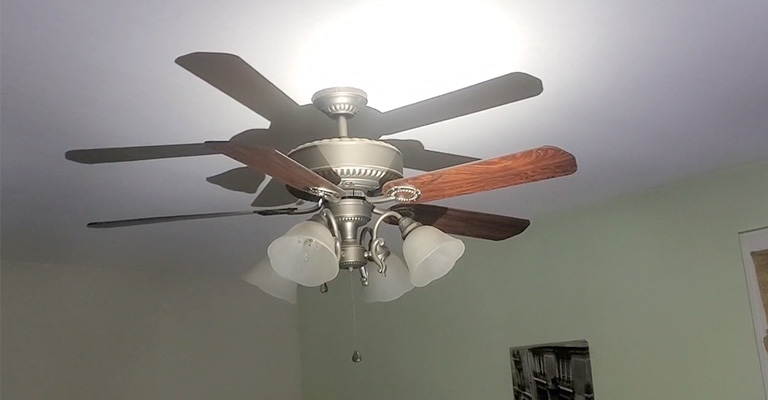Ceiling fans are a common and convenient addition to homes, providing a refreshing breeze and energy-efficient cooling during the hot summer months.
The Hunter brand, known for its high-quality craftsmanship and innovative designs, has been a popular choice among homeowners for decades.
However, imagine the perplexing scenario when your Hunter ceiling fan’s light flickers on and off seemingly at its own will, leaving you puzzled and searching for answers.
Before we dive into the potential reasons for this unusual behavior, it’s important to note that the information provided here is for educational purposes only.
Always consult a professional electrician or the manufacturer’s guidelines when dealing with electrical issues to ensure safety and accuracy.
The reliability of Hunter ceiling fans is known and trusted throughout the world. Sometimes, some problems can come as a surprise, especially if you haven’t used it for a while through the winter & it starts to warm up.
Why Does My Hunter Ceiling Fan Light Flicker On Then Off?
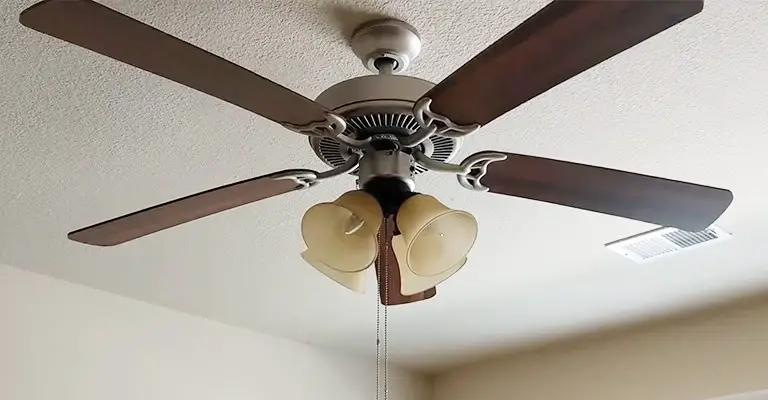
In most cases, the remote-control receiver is at fault when the fan or light turns on or off randomly.
As it is mounted in the fan’s canopy, it is exposed to interference from other sources in the same room or nearby.
There is a general pattern of using the same set of radio frequencies for different consumer products by manufacturers.
Therefore, a new Hi-Fi system or TV, or even simply rearranging items in the room, could trigger this.
It can be fixed by changing the radio channel on the receiver (usually through a dip switch) and also on the handset. You may be able to solve the problem if you change the radio channel your light uses.
Equipment like doorbells and garage door remotes use the same technology, so changing the radio channel should resolve the problem. There should be a guide in your manual to guide you.
1. The Lightbulb Is Defective Or About To Blow
Every time you lived in a home with electric lights, you probably saw a light bulb about to blow.
Toward the end of their useful lives, light bulbs behave erratically, flicker, turn off and on, and generally behave erratically until they blow out and never turn on again.
Whenever your ceiling fan light flickers rather than completely turning off or on, it is most likely caused by a defective bulb.
You can solve this problem by changing your light bulb proactively.
2. Faulty Wiring In The Wall Switch
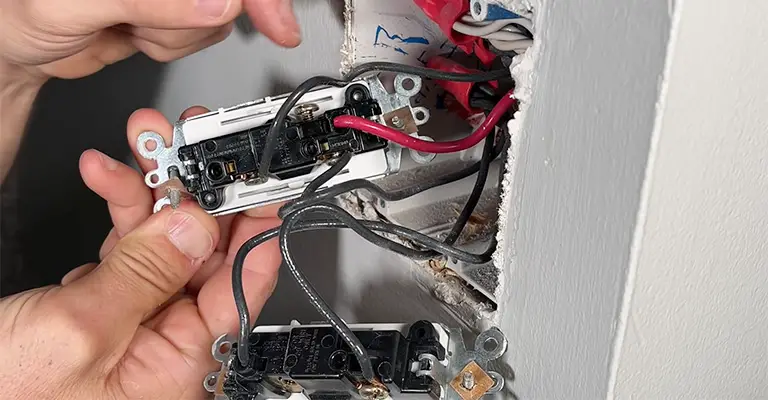
There is also a possibility that the wall switch could be faulty, very similar to faulty wiring in the fan itself.
Sometimes, you might have a single wall switch that turns the light and fan on and off, depending on your setup.
Try turning the switch off and on to determine if the wall switch is causing the issue. A switch may have problems if it occasionally fails to turn the light on and off.
If you’re not experienced or unsure of your capabilities, you should call a professional before replacing a wall switch!
3. Faulty Wiring Connection In The Fan
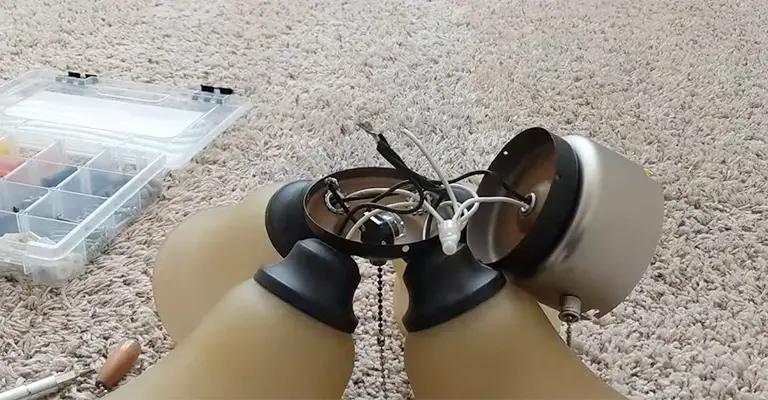
It is the worst cause of ceiling fan lights turning off and on by themselves of all the potential causes. Personally, I dislike the idea of dealing with electricity, and I find identifying and fixing electrical issues quite tedious.
A faulty wire can cause a variety of issues, but the most likely cause is intermittent or irregular power to the fan, so the light alternates between being on and off.
If the light stays on, you may need to tap the ceiling fan repeatedly to enable the light to turn off and on.
A faulty wiring usually occurs when the power connection barely holds on so that even the most minor movement can break it entirely and reconnect it.
It is not uncommon for ceiling fans to come loose after some time since they usually move and rock around a lot.
If you believe there is a loose connection, but cannot fix it yourself, then you can probably fix it yourself by following these steps:
- Ensure that the breaker is off for the ceiling fan
- Make sure the fan is off by testing the voltage
- You should remove the cover from the fan base.
- Determine the fan’s electrical connection.
- Ensure all electrical wires to the fan are disconnected, then reconnect them correctly, checking for any issues.
Don’t work with electricity if you aren’t certain that it is safe or if you aren’t comfortable doing it!
4. Other Technical Faults with a Hunter Ceiling Fan
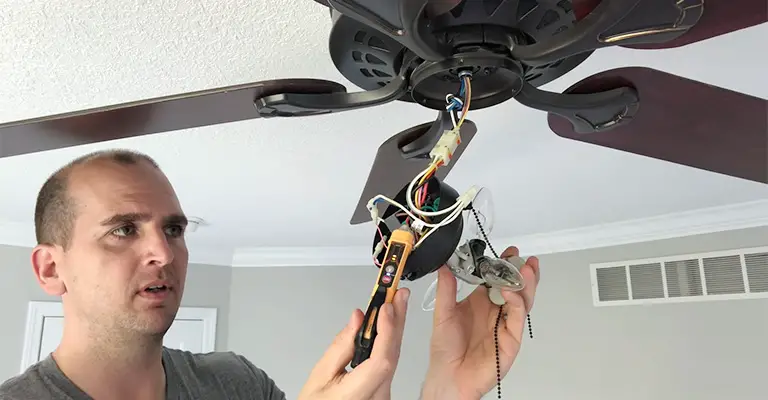
Once the fan is installed, it generally runs for years without any trouble and really does not need much attention until it malfunctions. We have listed the most common technical issues we encounter here.
The Fan Is Wobbling
When your fan is installed properly, there should be no wobble whatsoever. A fan with a trilobular mounting system that automatically balances itself or one with a simple balancing procedure can eliminate wobbling that causes annoying noises.
You should first try swapping the blades over to see if it fixes the problem. If the balance kit comes with a fan, you may be able to balance the fan by putting a small weight on one of the blades. Taking a bit of time to try and test should resolve this issue.
The Fan Makes A Humming Noise
Many reasons can contribute to this problem, but usually, it is related to a tightening issue for the screws.
Typically, it only takes 1/8 of a turn for a single screw to be installed. You could be talking about a blade iron to blade iron screw, a blade iron to fan screw, or even a blade iron to fan housing screw.
In addition, a dimmer switch may be connected to a fan. In cases where the noise is more like a buzz, it may be a defective capacitor, although this is rare since Hunter uses very high-quality capacitors.
It might also be because the motor laminates have failed if the fan is really old.
The Fan Speed Suffers Failures
There are times when some speeds don’t work as they should. The cause of this issue can be poor installation, a capacitor fault or failure, or an incorrect remote control setup.
The Light Has Stopped Working Or On Installation Does Not Work
Most likely, the cause is a faulty light kit, blown a fuse, wall switch or remote control (handset or receiver), broken light switch, or simply incorrect installation.
After my ceiling fan heated up, the light turned off. It turns out that the contacts that the bulb screws into lost contact due to the metal expanding.
You can try bending the contact out a bit to see if that helps. During this cleaning, you should also wipe it down. Don’t get shocked by the light by turning off the power.
The Fan Suddenly Stops Working Or, On Installation, Does Not Work
This is likely caused by the remote control handle or receiver, the wall control, incorrect installation (wiring up the fan incorrectly), or a broken switch or capacitor (if the fan worked previously).
Fixing The Issue: Hunter Fan Light Randomly Turns Off And Back On
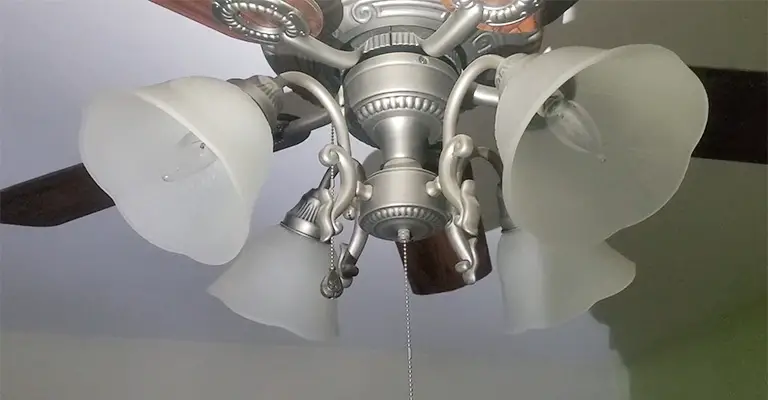
It all starts with the basics. You should contact Hunter’s customer service. If you have a remote, then normally, you will have to switch off the breaker or the light switch for at least 30 seconds so they can reprogram it.
The game gets stuck in demo mode, Hunter says. Reprogramming the remote was as simple as pressing the up and down buttons simultaneously and holding them until they flashed.
There is the option to change codes for both the receiver and remote in the fan base. Basically, you are getting radio interference that is causing the problem.
You can either change the codes by switching the switches around or by adding more dip clips which came with the fan. Whatever you do, change the codes in both the receiver and remote to the same code to resolve the problem.
Small switches (usually 5 or 6) in the battery area need to be changed, and you will have to take the fan down to do it.
The Bottom Line
It’s crucial to consult an electrician to eliminate any technical problems, but you should also consider environmental factors that could affect the fan.
Sometimes, flickering lights happen due to interference from other electronic devices, power surges, or fluctuations in the electrical supply.
Your electrical system should continuously be monitored for safety, no matter the reason. It is crucial to perform regular maintenance, including inspecting and tightening connections, to identify and resolve any issues which may be underlying.

